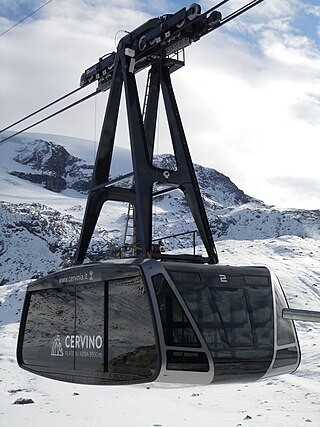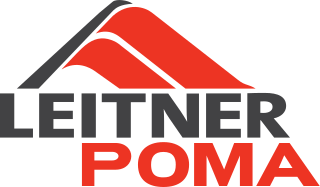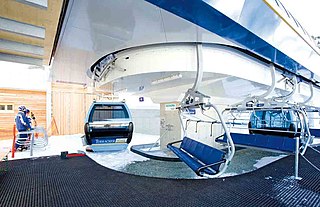
An aerial tramway, aerial tram, sky tram, aerial cablecar, aerial cableway, telepherique, or seilbahn is a type of aerial lift which uses one or two stationary ropes for support while a third moving rope provides propulsion. With this form of lift, the grip of an aerial tramway cabin is fixed onto the propulsion rope and cannot be decoupled from it during operations. In comparison to gondola lifts, aerial tramways generally provide lower line capacities and higher wait times.

Yan Lift, incorporated as Lift Engineering & Mfg. Co., was a major ski lift manufacturer in North America. Founded in 1965 and based in Carson City, Nevada, the company built at least 200 fixed-grip chairlifts, as well as 31 high-speed quads. The company's lifts have been involved in the deaths of five people and the injury of at least 70, the worst record of any ski-lift maker operating in North America.

A gondola lift is a means of cable transport and type of aerial lift which is supported and propelled by cables from above. It consists of a loop of steel wire rope that is strung between two stations, sometimes over intermediate supporting towers. The cable is driven by a bullwheel in a terminal, which is typically connected to an engine or electric motor. It is often considered a continuous system since it features a haul rope which continuously moves and circulates around two terminal stations. In contrast, an aerial tramway operates solely with fixed grips and simply shuttles back and forth between two end terminals.

An elevated passenger ropeway, or chairlift, is a type of aerial lift, which consists of a continuously circulating steel wire rope loop strung between two end terminals and usually over intermediate towers, carrying a series of chairs. They are the primary onhill transport at most ski areas, but are also found at amusement parks and various tourist attractions.

A detachable chairlift or high-speed chairlift is a type of passenger aerial lift, which, like a fixed-grip chairlift, consists of numerous chairs attached to a constantly moving wire rope that is strung between two terminals over intermediate towers. They are now commonplace at all but the smallest of ski resorts. Some are installed at tourist attractions as well as for urban transportation.

Doppelmayr/Garaventa Group is an international manufacturer of ropeways and people movers for ski areas, urban transport, amusement parks, and material handling systems. As of 2019, the group have produced over 15,000 installations in 96 countries. The Doppelmayr/Garaventa Group was formed in 2002 when Doppelmayr of Wolfurt, Austria merged with Garaventa AG of Switzerland to form the world's largest ropeway manufacturer.
Gimar Montaz Mautino (GMM) is a French manufacturer that was created by the merger of Gimar and Montaz-Mautino. They make aerial lifts and surface ski lifts. They are headquartered in Échirolles France, near Grenoble. Originally known as Montaz-Mautino, they were one of the most successful ski lift companies in the 1970s and 1980s, primarily constructing two and three-seat chairlifts.

An aerial lift, also known as a cable car or ropeway, is a means of cable transport in which cabins, cars, gondolas, or open chairs are hauled above the ground by means of one or more cables. Aerial lift systems are frequently employed in a mountainous territory where roads are relatively difficult to build and use, and have seen extensive use in mining. Aerial lift systems are relatively easy to move and have been used to cross rivers and ravines. In more recent times, the cost-effectiveness and flexibility of aerial lifts have seen an increase of gondola lift being integrated into urban public transport systems.
Poma, incorporated as Pomagalski S.A., and sometimes referred to as the Poma Group, is a French company which manufactures cable-driven lift systems, including fixed and detachable chairlifts, gondola lifts, funiculars, aerial tramways, people movers, and surface lifts. Poma has installed about 7800 devices for 750 customers worldwide.

The tricable gondola lift, also known as the 3S gondola lift, is a cable car system that was developed by the Swiss company Von Roll transport systems in Thun to unite the benefits of a gondola lift with those of a reversible cable car system. '3S' is an abbreviation of the German word dreiseil, meaning 'tricable'.

Leitner-Poma of America, known simply as Leitner-Poma, is a United States aerial lift manufacturer based in Grand Junction, Colorado. It is the American subsidiary of French-based Poma, which is owned by the Italian company HTI Group. The North American company was formed in 2000 when the Seeber Group, owner of Leitner, bought Poma and merged both companies' North American subsidiaries. Leitner-Poma of America operates a Canadian subsidiary based in Barrie, Ontario called Leitner-Poma Canada Inc.

The Tanigawadake Ropeway is Japanese aerial lift line, operated by Tanigawadake Ropeway Company. The Tōbu Group company also operates another aerial lift line, Harunasan Ropeway. Opened in 1960, the line climbs Mount Tanigawa Tenjindaira Ski Resort, Minakami, Gunma. The line is operated all seasons, transporting skiers, hikers, or tourists.
The Hashikurasan Ropeway is the name of Japanese aerial lift line in Ikeda, Tokushima, as well as its operator. The line climbs Mount Hashikura of Hashikura-dera, a famous temple.

Snow King Mountain is a summer and winter resort in the western United States, in Jackson, Wyoming. The mountain is Jackson's original 1936 ski hill, located on the southeast edge of the city, and was the first ski area in Wyoming. Locals sometimes refer to Snow King as "The Town Hill," and it offers skiing, hiking, an alpine slide, and many other attractions. The ski season runs from December to late March, and has a summer season that runs from June to October. Skiing is offered after the closure of lifts, until the snow is gone thanks to a boot pack trail on the west side of the resorts Runs. Hiking trails are offered all over the mountain.

A hybrid lift is a type of ski lift that combines the elements of a chairlift and a gondola lift. First introduced by Poma, who refers to them as Telemix, they have since been built by most lift manufacturers who refer to them by a variety of names; Doppelmayr refers to them as a combined lift, Bartholet refers to them with the French name, téléporté mixte, while the more generic terms chondola and telecombi are common in North America.
The Hausberg Gondola Lift runs from Garmisch-Partenkirchen in South Germany up to the Hausberg mountain and the "Classic" ski area of Hausberg-Alpspitze. It belongs to the Bayerische Zugspitzbahn company and is only operated in winter.






















